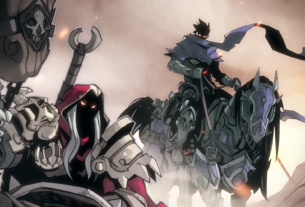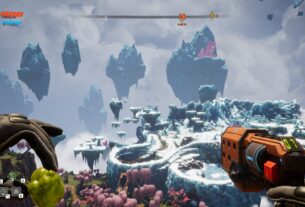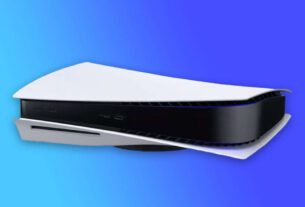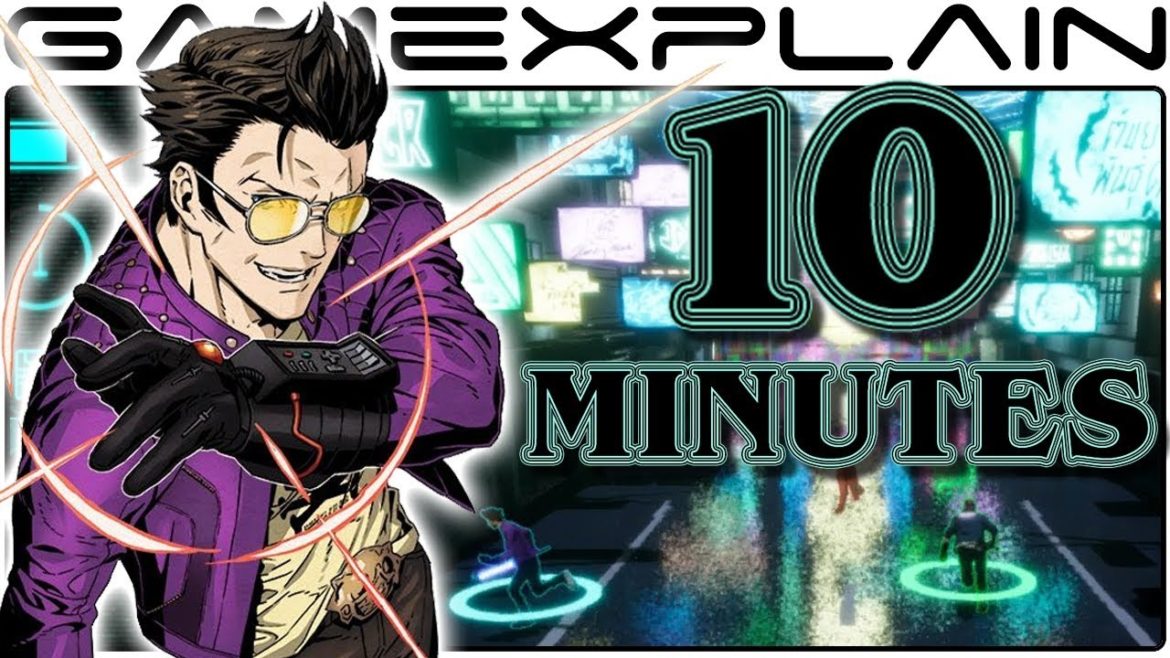
Relentless absurdity and hyper-stylized action have been core tenets of the No More Heroes series. It never cared for making much sense and instead embraced its own ridiculousness with bold self-awareness, a staple of director Suda51. The slimmed-down hack-n-slash spinoff, Travis Strikes Again, hits many of the same notes, but not as hard and with varying degrees of success. Its combat is frenetic, but well worn toward the end. Its story and style is unique, but thin in crucial moments. Its humor lands in spots, but not quite with a punch. But despite a middling delivery of what past games have done, there’s fun and charm packed into Travis Strikes Again, and if anything, it is a great example of local co-op action on Switch.
Seven years after the events of No More Heroes 2: Desperate Struggle, Travis Touchdown has removed himself from the world of assassination. The series’ too-cool-for-school protagonist now spends his days playing video games in a trailer nestled away in the backwoods of Texas. The father of past enemy Bad Girl, aptly named Bad Man, tracks him down for revenge, but he and Travis get sucked into an alternate dimension within Travis’ possessed Death Drive Mk II video game console. They end up working together to uncover the true nature of the haunted console and its games, and that’s how you get the co-op premise where you can play as either Travis or Bad Man in the six Death Drive games that serve as missions.
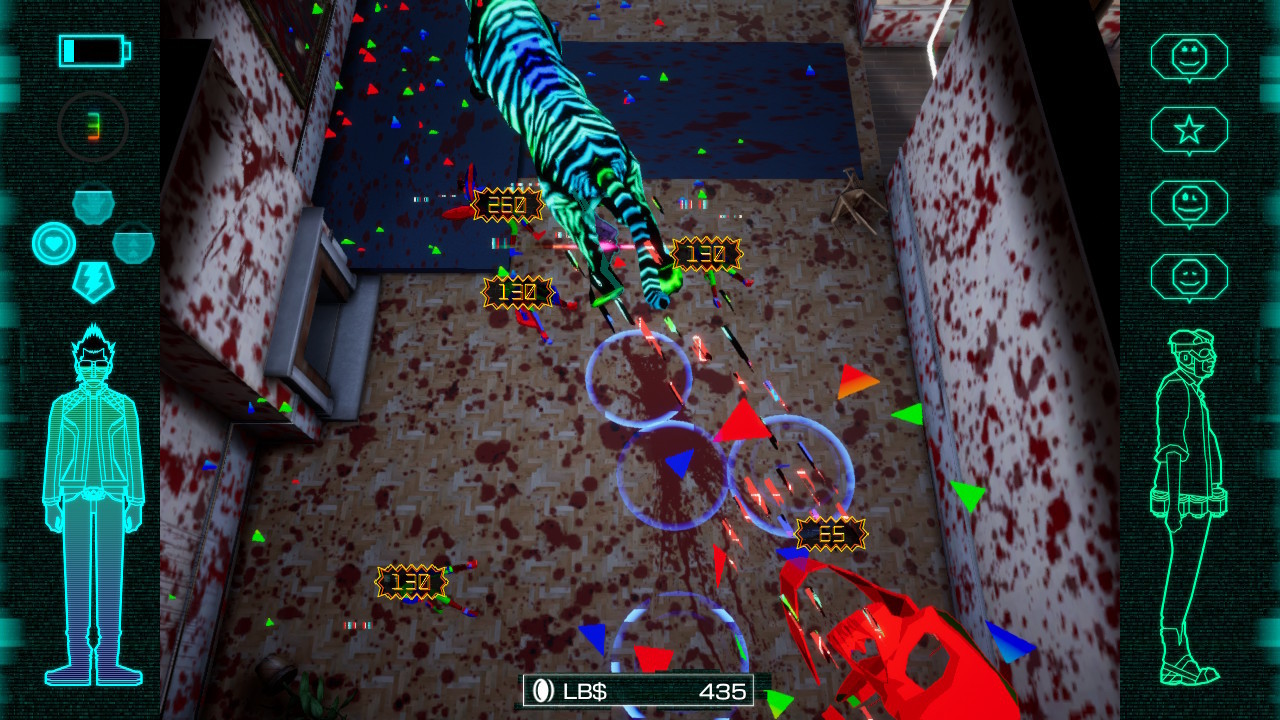










Travis Strikes Again primarily plays as a top-down hack-n-slash action game that pits you against hordes of enemies, referred to as “bugs,” that look like they’re from a digitized hellscape. Travis is still equipped with his trusty beam katana, but can now equip four unique abilities mapped to the face buttons, which can be activated when holding down the left bumper and operate on a cooldown. As you acquire more of these skills, called Chips, combat starts to open up and become more varied; finding what works for you and stringing together attacks with a preferred loadout is satisfying, especially when dealing with tougher enemies that require more than button-mashing to defeat. A personal favorite combo is a lightning strike to immobilize an enemy followed by a sticky bomb, then a “force push” to toss them into a crowd before the bomb goes off. Each of these abilities are also quite effective alone since they deal more damage and create openings. Along with heavy attacks that carry a nice, weighty feel and charge attacks that build up to bring out a literal tiger in Travis, you can’t help getting hyped up when powerful enemies like a Sheepman spawn into combat.
Throughout the game, attempts to break up the pace of core combat are half-baked implementations of fun ideas.
There’s more than enough to toy with in terms of combat skills, but basic level layouts that move you from one combat arena to another wear thin. The scenery changes and stronger enemies with different movesets show up, but the formula eventually stagnates. Aside from the tail end of the first mission, “Electric Thunder Tiger II,” and a late mission we won’t spoil, environments tend to be visually bare without much flair to match the over-the-top action. The “Coffee and Doughnuts” mission shifts to a side-scrolling view for a straightforward murder-mystery theme sprinkled with Twin Peaks references, but combat is limited in this perspective and rudimentary platforming doesn’t make up for it.
Missions are occasionally broken up with either a minigame or puzzle, but this isn’t enough to stave off the repetition perpetuated by the simplistic level design. The “Life Is Destroy” mission that tasks you with rotating pieces of a grid-based suburb to make a path forward adds a sweet puzzle element, but gets hampered by an enemy that chases you around and causes instant death on contact. A drag racing minigame in “Golden Dragon GP” brings along a novel twist, though it’s short-lived. Throughout the game, attempts to break up the pace of core combat are half-baked implementations of fun ideas.
There’s more than enough to toy with in terms of combat skills, but basic level layouts that move you from one combat arena to another wear thin. The scenery changes and stronger enemies with different movesets show up, but the formula eventually stagnates.
Battles get real spicy when the “Serious Moonlight” chapter rolls around (at the time of writing this review, we’re not at liberty to divulge its contents), but even then, the combat arena formula begins to overstay its welcome. And the conclusory mission devolves into a series of tedious mazes and Gauntlet-like fights in empty rooms. In boss battles, it’s enjoyable to recognize simple attack patterns and strike when the time’s right. But again, they don’t quite challenge you in interesting ways or make the impact you’d expect from a No More Heroes game.
Thankfully, the option for local cooperative play is streamlined and allows a second player to jump in at any time. Playing in co-op elevates the thrilling aspects in combat and makes the duller moments a bit more exciting, as you’ll coordinate with your partner to pull off skills and efficiently tear down enemies. The already intuitive control scheme also translates effortlessly to a single Joy-Con. Travis and Bad Man don’t differ much in combat capabilities, though there are a few Chips unique to each character, and while you’ll have to decide who gets to use which of the shared Chips in the early game, there’s enough to go around in later missions.
Progression is laid out neatly with each mission concluding in a boss fight followed by a narrative sequence about how Travis acquires the next game. He runs into a cast of quirky characters and bizarre situations in a monochrome screen-style visual novel, and it’s surprisingly intriguing. Creative visual representations of characters and places in the green-black color palette are elevated by catchy MIDI-tuned music (including the original No More Heroes theme) and amusing dialogue. It’s not without a bad joke or two, or a gag that doesn’t land, but the exceptional execution of a seemingly secondary element goes a long way for tying the overarching plot together, as disparate as it may seem.











The overtly crude-but-not-clever humor has been toned down this time around, and it’s for the better. Profanity-laced lines and toilet humor remain intact along with tongue-in-cheek jabs and references to gaming culture, and frequent fourth-wall breaking; even commentary on the struggles of being a game developer finds its way into dialogue. Travis’ brash attitude works most of the time as every other character keeps him in check, including his sassy cat Jeane–who talks and has an anime-inspired portrait in the story chapters–and the game bosses Travis encounters who he expresses reverence for. However, dialogue is rarely spoken, as there’s limited voice acting even in the game’s scant cutscenes.
As expected, the game is packed with references, purposefully ham-fisted, to drive home the overall absurdity of No More Heroes. It works at times, such as the Chips being named after Gundam (Strike Freedom, F91, and Atlas, to name a few) and a story chapter that uses Suda’s own The 25th Ward: The Silver Case as a narrative device. There’s even a Jeff Minter stand-in character who’s crucial to the plot of finding the original Death Drive developer. A late-game reveal proves to be the boldest of them all, especially for those fond of a particular past Suda51 game. And there’s a slew of shirts you can equip with key art from other independent games (like Undertale, Hyper Light Drifter, and many more). As heavy-handed as some references may be, they’re at least consistent with the game’s personality, and if anything, liven up its tone.
This is not the return of No More Heroes you’d hoped for, but it at least shows signs of a series that still has life in it.
Once you’ve sifted through the references and callbacks, you have a competent action game with some great ideas that are only halfway there. Slashing through waves of deformed bugs and hardened brutes has its moments, highlighted by a seamless co-op system that makes jumping into the action a breeze, and the minimalist story presentation will draw you into the journey. However, Travis Strikes Again: No More Heroes doesn’t quite deliver on its potential, relying too heavily on repetitive encounters. This is not the return of No More Heroes you’d hoped for, but it at least shows signs of a series that still has life in it.

